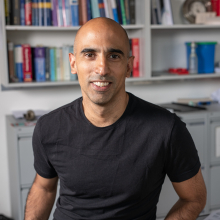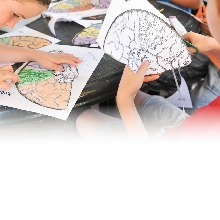A winning match
Joy Argaman’s 24-year journey with Copaxone® has kept her on the tennis court
Briefs

When Joy Argaman (pictured above) was diagnosed with multiple sclerosis in 1993 at age 34, she was a competitive tennis player whose athleticism was an important part of her personal identity. But few effective treatments were on the market. “‘Wait and see’ is all that my doctor was able to tell me,” recalls Ms. Argaman, who was born and raised in Des Moines, Iowa, and has lived in Herzliya for the last 36 years. She was given the standard steroid treatment available at the time, but she was increasingly suffering, “and feeling like I had lost control of my body.”
Two years later, she enrolled in the clinical trial for Copaxone® overseen by Teva Pharmaceuticals. She has been on the drug ever since, which she says has allowed her to live a fulfilling family life alongside a demanding career—she manages dozens of people as a Business Controls Manager at IBM—and family, and continues to play competitive tennis. She won her first medal in the Maccabiah Games two months after being diagnosed and throughout 20 years and six Maccabiah Games, she has won two bronze, three silver, and four gold medals.
Unrelated to her illness and her experience with Copaxone®, her uncle, Marvin Pomerantz of Des Moines, made a gift in 1999 to establish the Rose Lee and Marvin Pomerantz Scholarship. Later, as a way of acknowledging the importance of immunological research to his niece’s recovery, he earmarked the scholarship for PhD students studying in the lab of Prof. Steffen Jung in the Department of Immunology. The immunology research of Prof. Michael Sela and Prof. Ruth Arnon laid the foundation for Copaxone®'s development.
This summer, at age 59, Ms. Argaman competed in her seventh Maccabiah in the women’s doubles and mixed doubles tournaments and won a gold medal in the Maccabiah Games’ Women’s 55 and over category. It was her tenth medal. “I believe that the combination of the Copaxone®, acupuncture, and all the sports I do have been the key to my success,” she says.
After her win this summer, she wrote an emotional letter of thanks to Profs. Sela and Arnon. “I was very fortunate to be diagnosed in 1993 in Israel, and not just a few years earlier somewhere else in the world,” she says. “Timing is everything in life. With heartfelt gratitude beyond words I thank you on a personal level for your achievements, perseverance, and brilliance as scientists. I have no doubt that you have saved the quality of my life.” Prof. Arnon responded to her: “My life as a scientist is very interesting and full of excitements,” wrote Prof. Arnon. “But what really touches my heart is your incredible story. There is nothing comparable to it. It is a huge victory for you and I thank you so much for sharing it with us. It gives me new meaning to life.” And so did Prof. Sela: “I realize that this success story is not only about tennis—for which you should be congratulated—but about quality of life, and Copaxone’s role in it. I am very moved by this, and actually very emotional. Let it stay this way forever!”








